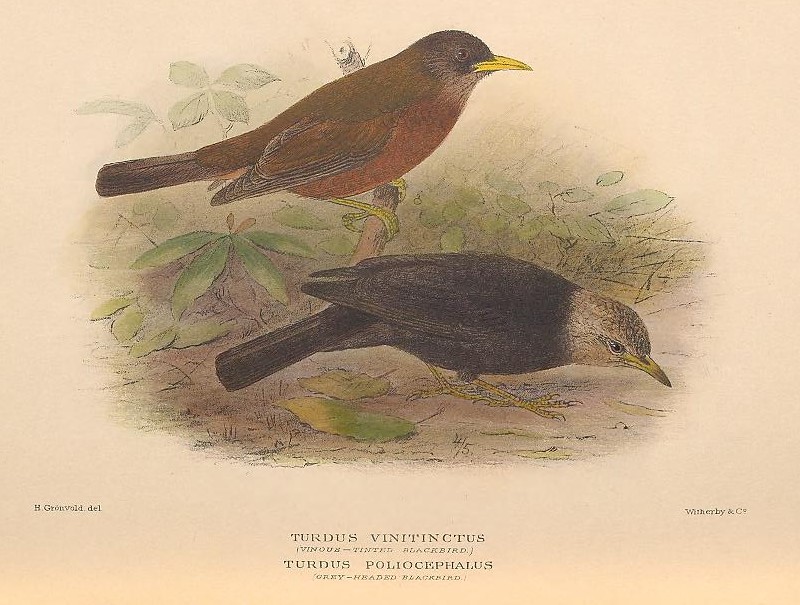Turdus poliocephalus vinitinctus (Gould, 1855:165)
Vinous-tinted thrush, Vinous-tinted blackbird, Ouzel, Lord Howe Island vinous-tinted blackbird, Doctor bird
Taxonomy & Nomenclature
Synonym/s: Merula vinitincta Gould, 1855:165 (original combination); Turdus vinotinctus (Gould, 1855:165); Turdus (poliocephalus) xanthopus vinitinctus Gould, 1855:165
Conservation Status
Extinct
Last record: 1913 (Bell, 1913-14)
IUCN RedList status: Extinct
The Vinous-tinted thrush (Turdus poliocephalus vinitinctus) likely became extinct in 1918 or later as a result of the escape of Black rats ([i]Rattus rattus[/i]) from a nearby shipwreck which managed to swim ashore and colonize Lord Howe Island (Hindwood, 1940).
Distribution
Lord Howe Island, New South Wales, Australia
Biology & Ecology
Hypodigm
Syntypes:
BMNH 1855.1.23.5 (adult, male)
BMNH [accession no.?] (adult, female)
Other specimens:
[url=http://nlbif.eti.uva.nl/naturalis/detail.php?lang=uk&id=18]RMNH 110.036[/url] (female)
Media

Above: illustration (top bird) from Mathews (1928).
References
Original scientific description:
Gould, John. (1855). On some new species of birds collected by Mr McGillivray. Proceedings of the Zoological Society of London 1855(23): 164-166.
Other references:
Bell, Roy. (1913-14). Lord Howe Island Journal (Bird collections, etc.). Unpub. (xerox copy from typescript of handwritten Ms.) Aust. Mus. Library.
BirdLife International. (2012). Turdus poliocephalus. In: IUCN 2013. IUCN Red List of Threatened Species. Version 2013.1. (http://www.iucnredlist.org). Downloaded on 30 August 2013.
Day, David. (1981). The Doomsday Book of Animals: A Natural History of Vanished Species. New York, N.Y.: The Viking Press.
Department of Environment and Climate Change (NSW). (2007). Lord Howe Island Biodiversity Management Plan Appendices. Department of Environment and Climate Change (NSW), Sydney. vii + 267 pp.
Etheridge, R. (1889). The general zoology of Lord Howe Island; containing also an account of the collections made by the Australian Museum Collecting Party, Aug.–Sept., 1887. Australian Museum Memoir 2(1): 1-42, plates iv–v.
Garnett, Stephen (ed.). (1992). Threatened and Extinct Birds of Australia. RAOU Report Number 82. 212 pp.
Hindwood, Keith A. (1938). The extinct birds of Lord Howe Island. Australian Museum Magazine 6(9): 319-324.
Hindwood, K. A. (1940). The birds of Lord Howe Island. Emu 40: 1-86.
Hull, Arthur Francis Basset. (1909). The birds of Lord Howe and Norfolk Islands. Proceedings of the Linnean Society of New South Wales 34: 636-693, pls. l-liv. [p. 685]
Hutton, Ian. (1991). Birds of Lord Howe Island: Past and Present. Coffs Harbour Plaza, N.S.W.: Self Published. 154 pp.
Knox, Alan G. and Walters, Michael P. (1994). Extinct and endangered birds in the collections of The Natural History Museum. British Ornithologists' Club Occasional Publications 1: 1-292. [pp. 211-213]
Mathews, Gregory Macalister. (1928). The Birds of Norfolk & Lord Howe Islands and the Australasian South Polar Quadrant: with additions to "birds of Australia". London: H.F. & G. Witherby. xii + 139 pp, pls 1-45. [p. 47, pl. 26]
McAllan, Ian A. W., Curtis, Brian R., Hutton, Ian and Cooper, Richard M. (2004). The Birds of Lord Howe Island Group: A Review of Records. Australian Field Ornithology 21(Supplement): 1-82.
McCulloch, Allan R. (1921). Lord Howe Island–a naturalist's paradise. Australian Museum Magazine 1(2): 31-47.
Recher, H. F. (1974). Colonisation and extinction: the birds of Lord Howe Island. Australian Natural History 18(2): 64-69.
Sclater, P.L. 1861. Remarks on the geographical distribution of the genus Turdus. Ibis 3(11): 277-283.
Woinarski, John C. Z., Legge, Sarah M. and Garnett, Stephen T. (2024). Extinct Australian birds: numbers, characteristics, lessons and prospects. Emu 124(1): 8-20. https://doi.org/10.1080/01584197.2023.2240345
http://extinctanimals.proboards.com/thread/8827/turdus-poliocephalus-vinitinctus-lord-thrush
